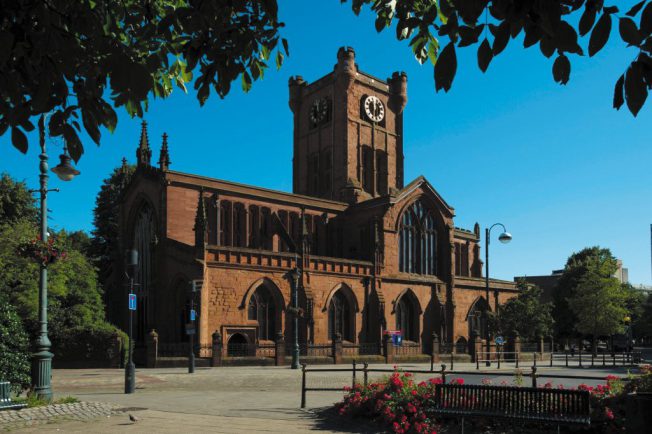‘QUEEN Isabella’ will be in Coventry this Saturday (April 23) with her faithful knight to celebrate St George’s Day in style at the Grade I listed St John the Baptist church.
The mediaeval Queen will be hosting a special celebratory open day, from 10am to 4pm, where she will accompany visitors on guided tours of the beautiful rose sandstone church, with its intricate carvings, altar pieces, spectacular stained glass and unusual raised graveyard.
They will learn more about the history of Coventry’s ‘mediaeval gem’ next to historic Spon Street in the city centre, and its link to England’s patron saint.
During the morning, stained glass expert Ben Sinclair will explain the art and craft of mediaeval and modern glass.
Visitors can enjoy music recitals on the organ and from recorder player Anne Childs; photographic and historic exhibitions; a children’s trail and book sale.
There will also be traditional English dance by Coventry Morris Men.
At 1pm people can see a live performance of the St George play by the Coventry Mummers – when George will bravely take on the fearsome dragon in mortal combat.The church hall cafeteria will be open for food and drink.
St John’s church warden, Ann Tuesley, said: “We are delighted to welcome visitors to our beautiful church to celebrate the life and legend of St George, the patron saint of England. Two of the oldest artefacts still remaining in the church are the sculptures of St George and the dragon, which can be found on either side of the east window.
“They date from around the late 14th and early 15th century, when legend grew in England that St George was originally born in Coventry – unfortunately, untrue.
“English soldiers had long since thrown aside banners proclaiming Edward the Confessor as the patron of their country for the more dynamic cross of St George. That fashion gained momentum during the reign of King Edward III, the son of our church’s founder, Queen Isabella.
“St George never even visited England, but the legend grew that he was born at Caludon Castle outside the city walls, the son of Lord Albert, and was a killer of dragons, lions and infidels – before returning to Coventry to kill a dragon that was terrorising the locals.
“Coventrians saw the financial possibilities of the legend and resultant pilgrimages. A shrine to George stood in the Priory, statues were erected in St John’s and a chapel and guild in Gosford Street was dedicated to him.
“A highly ornate silver gilt cup engraved with the image of St George was stored in the Guildhall treasury, along with his silver shield.
“The only artefacts that have survived are the statues in St John’s, which will have pride of place in our St George’s Day Open Day – and we will naturally be flying the St George flag. We look forward to welcoming people from near and far to celebrate the life and legend of St George in one of the country’s most historic and beautiful churches.”
The parish of St John the Baptist came into being when Queen Isabella granted a Royal Charter in May 1344, to build a church on the piece of land formerly known as the ‘Babbelak’ (now Bablake) – which it’s said she did to repent from having a hand in the death of her husband, King Edward II.
As the only royal church in Coventry, St John’s continued to enjoy patronage from the monarchy for many years, including the Queen’s grandson, Edward the Black Prince, until King Henry VIII decided to form the Church of England for his own personal and political reasons.
Following the dissolution of the monasteries, St John’s was closed for worship and during the Civil War it was used as a hospital for imprisoned Scottish Royalist soldiers, following the Battle of Preston in 1648.
The people of Coventry were Parliamentarians, so gave the prisoners a frosty reception – thought to be the origin of the saying ‘sent to Coventry’.
As time passed the church building was used as a stretch yard, as part of Coventry’s weaving and dying industry, along with being a corn exchange – the origin of the city’s market – before finally being restored as a place of worship in 1734.











